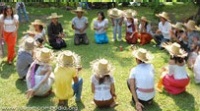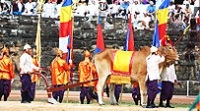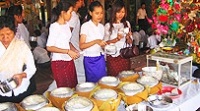|
The Kingdom of Cambodia has a wealth of traditional and cultural festivals dated according to the Cambodian lunar calendar. All of these festivals are influenced by the concepts of Buddhism, Hinduism, and royal cultures. The festivals, which serve as a source of great joy, merriment and Cambodia’s national colors, play a major role in influencing tourists’ opinions, behaviors, and options. Most of these are a time of great rejoicing for the predominantly urban and the rural populace. Nowadays the whole nation unites in understanding its cultural values and traditions.
There follows a list of the more important national festivals in the Khmer calendar:

THE THREE DAYS OF KHMER NEWY YEAR:
Maha Sangkran
It marks the beginning of a fresh year generally, people would dress themselves up and visit temples to make offerings, light candles and burn incense to pray for their ancestors the goodness.
Virak Banabat
Cambodian observes this day by sharing and contributing to the less fortunate; charity for the poor and homeless people.
Thngay Leung Saka
On this, the third day of celebration, people would bathe their parents or the elderly at home; ceremoniously pouring perfumed water over their hands and Buddhists would bathe statues of the Buddha that belief to get rid of sin they might do in the past.
|
KHMER NEW YEAR
The Khmer New Year, or 'Bon Chol Chhnam Thmei' in the Khmer language, is commonly celebrated on 13th April each year although sometimes the holiday may fall on the 14th April in keeping with the Cambodian lunar calendar. This marks the end of the harvest season when farmers enjoy the fruits of their labor and relax before the start of the rainy season. The New Year holidays last for three days:
Bonn chaul chhnam is the Khmer equivalent of songkran in Thailand and phimai in Laos. Cambodians clean and decorate their houses, make offerings at the local temple and throw water at each other as a form of blessing. City streets are decorated and brightly lit in the evenings and special cultural, entertainment and sporting events are organized especially for the occasion.
During this time, people engage in traditional Khmer games; they paly such games as the Bas Angkunh 'seed throwing', Chaol Chhoung 'twisted-scarf throwing', Leak Kanséng 'twisted-scarf hide', tug of war, shuttlecock kicking, etc. Throughout the country, people merrily dance the traditional Khmer forms of the Ran Vong, Ram Kbach, Saravan, and Lam Leav in the open.
|

ROYAL PLOUGHING DAY
Also know as Farmer’s Day, the ceremony is rooted in Brahman belief, and is held to ensure a good harvest. It marks the beginning of rice growing season usually held on the 4th day of the 6th lunar month’s waning moon.
|
KROYAL PLOUGHING CEREMONY
The Royal Ploughing Ceremony, or 'Bon Chroat Preah Nongkoal' in the Khmer language, is solemnly celebrated at the beginning of the sowing and planting season. Every year in May, this cultural ceremony takes place at the park in front of the National Museum (next to the Royal Palace). Cambodia has deep connection with earth and farming. There is a deep astrological belief that royal oxen known in Khmer as Usapheak Reach, have an instrumental role in determining the fate of the agricultural harvest each year.
Traditionally, the King Meak, representing the king of Cambodia, ploughs the field whilst the Queen, the Preah Mehuo, sows seeds from behind. The field is ceremoniously ploughed three times around. The royal servants then drive the royal oxen to seven golden trays containing rice, corn, sesame seeds, beans, grass, water, and wine to feed. The predictions are made for the coming year based upon what they select. The harvest will be good if they choose the cereals, rain will be abundant if they drink water, but trouble is feared if they eat herbs or drink alcohol.
|

Three Ceremonies Underpin
The Entire Water Festival
Loy Pratip
An evening fluvial parade, featuring beautiful illuminated boats lighting up the waterways, Government institutions each sponsor a boat on the parade.
Sampeas Preah Khét
Salutation to the moon. The full moon is highly regarded and people give thanks to the moon on Boun Om Touk, and pray for a bountiful harvest ahead.
Auk Ambok:
At midnight, celebrants gather at temples to eat “Ambok” (flattened rice), which is basically rice fried with the husk still intact. They then pound to remove the husk, and mixed the flattened rice with banana and coconut.
|
WATER FESTIVAL, MOON FESTIVAL
The Water Festival, a spectacle to behold, is probably the most exorbitant festival held each year in November. It is usually celebrated for three days, i.e. the 14th and 15th of the waxing moon and the 1st of the waning moon of the month of Kadek. The 15th of the waxing moon is the last full moon day.
The festival ushers in the fishing season, marks a change in the flow of the Tonlé Sap and the ebbing-water season, and is seen as thanksgiving to the Mekong River for providing the country with fertile land and abundant fish.
At the height of the rainy season, the water of the Mékong River forces the Tonlé Sap to reverse its current and to flow up to the Tonlé Sap Lake. As the water of the Mékong River begins to subside, the swollen Tonlé Sap Lake flows back to the Mékong River through the Tonlé Sap and empties into the sea, which leaves behind vast quantities of fish. This, indeed, is a remarkable phenomenon of the Tonlé Sap.
This unique natural phenomenon is celebrated with three days of boat races, fairs, festivals, shows, parades, fireworks, music and dancing.
|
PCHUM BEN or ALL SOULS DAY
 Running for 15 days, usually from the end of September into October, this festival is dedicated to blessing the spirits of the dead and is one of the most culturally significant in Cambodia. The exact date defers year to year as determined by the lunar calendar. Each household visits their temple of choice and offers food to the monks.
Offering of food is a meritorious act and is one of the oldest and most common rituals of Buddhism. During the Pchum Ben festival, people bring food to the temple for the monks and to feed hungry ghosts who could be their late ancestors, relatives or friends. Pagodas are usually crowded with people taking their turn to make offerings and to beg the monks to pray for their late ancestors and loved ones. Many remain behind at the temple to listen to Buddhist sermons. Running for 15 days, usually from the end of September into October, this festival is dedicated to blessing the spirits of the dead and is one of the most culturally significant in Cambodia. The exact date defers year to year as determined by the lunar calendar. Each household visits their temple of choice and offers food to the monks.
Offering of food is a meritorious act and is one of the oldest and most common rituals of Buddhism. During the Pchum Ben festival, people bring food to the temple for the monks and to feed hungry ghosts who could be their late ancestors, relatives or friends. Pagodas are usually crowded with people taking their turn to make offerings and to beg the monks to pray for their late ancestors and loved ones. Many remain behind at the temple to listen to Buddhist sermons.
Footnote:
"Hungry ghost" is one of the six modes of existence in the ‘Wheel of Life’. Hungry ghosts or ‘Preta’ which means ‘departed ones’ in Sanskrit, are pitiable creatures with huge, empty stomachs and pinhole mouths; their necks are so thin they cannot swallow, so they remain hungry. It is believed that beings are reborn as hungry ghosts because of their greed, envy and jealousy.
Cambodians leave food offerings on altars and around temple grounds for hungry ghosts. Pchum Ben is a festival that features food and entertainment for such hungry ghosts.
Other important ceremonies
Bonn Visak Bochea
Mid May, one day
This nationwide festival commemorates the day of the Buddha's birth, enlightenment and death. Held during the sixth full moon of the lunar calendar, it involves chanting, sermons and a candlelit procession to the wat.
Bonn Chol Vassa - Start of Buddhist Lent
Mid July, two days
Held to coincide with the eighth full moon of the lunar calendar, this festival marks the beginning of the three-month Buddhist lent, when Buddhist monks fast and meditate. Young men consider this festival auspicious for entering the monkhood.
Bonn Kathen - End of Buddhist Lent
October-November, one month
Starting immediately after the last day of lent and lasting until the next full moon, this religious festival marks the emergence of monks from retreat. People all over the country form reverent slow processions to their local temple to offer them robes and other items, thereby bringing spiritual merit to all participants.
Independence Day
9 November
Each year 9 November is a national holiday, held to celebrate the independence of Cambodia from France in 1953. A gala parade is held in front of the Royal Palace, which includes floats, marching bands and other entertaining festive activities.
INTERNATIONAL EVENTS
Johnnie Walker Cambodian Open golf tournament
 Cambodia is regular host to the Johnnie Walker Cambodian Open golf tournament. There are many golf courses in Cambodia; all of which are of international standard. The Angkor Golf Resort is designed by six-time big winner Nick Faldo and it is claimed that this course could emerge as not only the finest in Cambodia, but one of the best in the Asia-Pacific region. This 18-Hole course is a challenging 7279 yards, par 72 that is built to challenge all levels of golfers and has been rated by the US PGA. Cambodia is regular host to the Johnnie Walker Cambodian Open golf tournament. There are many golf courses in Cambodia; all of which are of international standard. The Angkor Golf Resort is designed by six-time big winner Nick Faldo and it is claimed that this course could emerge as not only the finest in Cambodia, but one of the best in the Asia-Pacific region. This 18-Hole course is a challenging 7279 yards, par 72 that is built to challenge all levels of golfers and has been rated by the US PGA.
Angkor Wat International Half Marathon
 Cambodia is also host to the Angkor Wat International Half Marathon annually. The event attracts thousands of runners from more than 40 countries around the world. Cambodia is also host to the Angkor Wat International Half Marathon annually. The event attracts thousands of runners from more than 40 countries around the world.
This international charity event has been running at Angkor since 1996. Not only does it support good causes, especially benefiting mine victims and other worthy beneficiaries in Cambodia, this awesome event is annually held at the Angkor Archeological Park, one of the most important archeological sites is South-East-Asia, making it a true attraction not to be missed.
Angkor Photography Festival
Photography for Change. Annual festival that showcases outdoor projections and various exhibitions around Siem Reap of regional and international photographers. The festival is held during the last week of November every year, consisting of 7 evenings of outdoor projections and more than 10 gallery exhibitions across various venues in the city. The festival is the first of its kind in Southeast Asia and is also the biggest. It aims to highlight the work of Asian photographers and provides free workshops for 30 young photographers from the region every year, led by world renowned professionals, which are showcased during the event. There is a full time office/gallery for the festival located on the East river road near the Bopha Angkor Hotel. As well as the festival, the organisers support a local NGO working with street children, that promotes the arts and runs a photography course with students. Photography from these students is also showcased as part of the festival programme.
|







 Running for 15 days, usually from the end of September into October, this festival is dedicated to blessing the spirits of the dead and is one of the most culturally significant in Cambodia. The exact date defers year to year as determined by the lunar calendar. Each household visits their temple of choice and offers food to the monks.
Offering of food is a meritorious act and is one of the oldest and most common rituals of Buddhism. During the Pchum Ben festival, people bring food to the temple for the monks and to feed hungry ghosts who could be their late ancestors, relatives or friends. Pagodas are usually crowded with people taking their turn to make offerings and to beg the monks to pray for their late ancestors and loved ones. Many remain behind at the temple to listen to Buddhist sermons.
Running for 15 days, usually from the end of September into October, this festival is dedicated to blessing the spirits of the dead and is one of the most culturally significant in Cambodia. The exact date defers year to year as determined by the lunar calendar. Each household visits their temple of choice and offers food to the monks.
Offering of food is a meritorious act and is one of the oldest and most common rituals of Buddhism. During the Pchum Ben festival, people bring food to the temple for the monks and to feed hungry ghosts who could be their late ancestors, relatives or friends. Pagodas are usually crowded with people taking their turn to make offerings and to beg the monks to pray for their late ancestors and loved ones. Many remain behind at the temple to listen to Buddhist sermons. Cambodia is regular host to the Johnnie Walker Cambodian Open golf tournament. There are many golf courses in Cambodia; all of which are of international standard. The Angkor Golf Resort is designed by six-time big winner Nick Faldo and it is claimed that this course could emerge as not only the finest in Cambodia, but one of the best in the Asia-Pacific region. This 18-Hole course is a challenging 7279 yards, par 72 that is built to challenge all levels of golfers and has been rated by the US PGA.
Cambodia is regular host to the Johnnie Walker Cambodian Open golf tournament. There are many golf courses in Cambodia; all of which are of international standard. The Angkor Golf Resort is designed by six-time big winner Nick Faldo and it is claimed that this course could emerge as not only the finest in Cambodia, but one of the best in the Asia-Pacific region. This 18-Hole course is a challenging 7279 yards, par 72 that is built to challenge all levels of golfers and has been rated by the US PGA. Cambodia is also host to the Angkor Wat International Half Marathon annually. The event attracts thousands of runners from more than 40 countries around the world.
Cambodia is also host to the Angkor Wat International Half Marathon annually. The event attracts thousands of runners from more than 40 countries around the world.